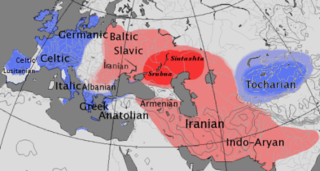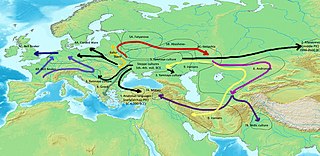Related Research Articles

Armenian is an Indo-European language and the sole member of an independent branch of that language family. It is the native language of the Armenian people and the official language of Armenia. Historically spoken in the Armenian highlands, today Armenian is widely spoken throughout the Armenian diaspora. Armenian is written in its own writing system, the Armenian alphabet, introduced in 405 AD by the canonized saint Mesrop Mashtots. The estimated number of Armenian speakers worldwide is between five and seven million.

The Indo-European languages are a language family native to the overwhelming majority of Europe, the Iranian plateau, and the northern Indian subcontinent. Some European languages of this family—English, French, Portuguese, Russian, Dutch, and Spanish—have expanded through colonialism in the modern period and are now spoken across several continents. The Indo-European family is divided into several branches or sub-families, of which there are eight groups with languages still alive today: Albanian, Armenian, Balto-Slavic, Celtic, Germanic, Hellenic, Indo-Iranian, and Italic; another nine subdivisions are now extinct.

Armenians are an ethnic group and nation native to the Armenian highlands of West Asia. Armenians constitute the main population of the Republic of Armenia and constituted the main population of the unrecognized Republic of Artsakh until the flight of Armenians from Nagorno-Karabakh. There is a wide-ranging diaspora of around five million people of full or partial Armenian ancestry living outside modern Armenia. The largest Armenian populations today exist in Russia, the United States, France, Georgia, Iran, Germany, Ukraine, Lebanon, Brazil, Argentina, Syria, and Turkey. The present-day Armenian diaspora was formed mainly as a result of the Armenian genocide with the exceptions of Iran, former Soviet states, and parts of the Levant.

The Phrygian language was the Indo-European language of the Phrygians, spoken in Anatolia, during classical antiquity.

Proto-Indo-European (PIE) is the reconstructed common ancestor of the Indo-European language family. No direct record of Proto-Indo-European exists; its proposed features have been derived by linguistic reconstruction from documented Indo-European languages.

The Balto-Slavic languages form a branch of the Indo-European family of languages, traditionally comprising the Baltic and Slavic languages. Baltic and Slavic languages share several linguistic traits not found in any other Indo-European branch, which points to a period of common development and origin.
The glottalic theory is that Proto-Indo-European had ejective or otherwise non-pulmonic stops, *pʼ *tʼ *kʼ, instead of the plain voiced ones, *b *d *ɡ as hypothesized by the usual Proto-Indo-European phonological reconstructions.

The Paleo-Balkan languages are a geographical grouping of various Indo-European languages that were spoken in the Balkans and surrounding areas in ancient times. In antiquity, Dacian, Greek, Illyrian, Messapic, Paeonian, Phrygian and Thracian were the Paleo-Balkan languages which were attested in literature. They may have included other unattested languages.

Graeco-Aryan, or Graeco-Armeno-Aryan, is a hypothetical clade within the Indo-European family that would be the ancestor of Hellenic, Armenian, and the Indo-Iranian languages, which spans Southern Europe, Armenian highlands and Southern Asian regions of Eurasia.
In historical linguistics, Italo-Celtic is a hypothetical grouping of the Italic and Celtic branches of the Indo-European language family on the basis of features shared by these two branches and no others. There is controversy about the causes of these similarities. They are usually considered to be innovations, likely to have developed after the breakup of the Proto-Indo-European language. It is also possible that some of these are not innovations, but shared conservative features, i.e. original Indo-European language features which have disappeared in all other language groups. What is commonly accepted is that the shared features may usefully be thought of as Italo-Celtic forms, as they are certainly shared by the two families and are almost certainly not coincidental.
The linguistic classification of the ancient Thracian language has long been a matter of contention and uncertainty, and there are widely varying hypotheses regarding its position among other Paleo-Balkan languages. It is not contested, however, that the Thracian languages were Indo-European languages which had acquired satem characteristics by the time they are attested.

The Armenian hypothesis, also known as the Near Eastern model, is a theory of the Proto-Indo-European homeland, initially proposed by linguists Tamaz V. Gamkrelidze and Vyacheslav Ivanov in the early 1980s, which suggests that the Proto-Indo-European language was spoken during the 5th–4th millennia BC in "eastern Anatolia, the southern Caucasus, and northern Mesopotamia".

Proto-Armenian is the earlier, unattested stage of the Armenian language which has been reconstructed by linguists. As Armenian is the only known language of its branch of the Indo-European languages, the comparative method cannot be used to reconstruct its earlier stages. Instead, a combination of internal and external reconstruction, by reconstructions of Proto-Indo-European and other branches, has allowed linguists to piece together the earlier history of Armenian.

Languages of the Indo-European family are classified as either centum languages or satem languages according to how the dorsal consonants of the reconstructed Proto-Indo-European language (PIE) developed. An example of the different developments is provided by the words for "hundred" found in the early attested Indo-European languages. In centum languages, they typically began with a sound, but in satem languages, they often began with.

The Armeno-Phrygians are a hypothetical people of West Asia during the Bronze Age, the Bronze Age collapse, and its aftermath. They would be the common ancestors of both Phrygians and Proto-Armenians. In turn, Armeno-Phrygians would be the descendants of the Graeco-Phrygians, common ancestors of Greeks, Phrygians, and also of Armenians.
Graeco-Phrygian is a proposed subgroup of the Indo-European language family which comprises the Hellenic and Phrygian languages.

The Indo-European migrations are hypothesized migrations of Proto-Indo-European language (PIE) speakers, and subsequent migrations of people speaking derived Indo-European languages, which took place approx. 4000 to 1000 BCE, potentially explaining how these languages came to be spoken across a large area of Eurasia, spanning from the Indian subcontinent and Iranian plateau to Atlantic Europe, in a process of cultural diffusion.

The name Armeno-Phrygian is used for a hypothetical language branch, which would include the languages spoken by the Phrygians and the Armenians, and would be a branch of the Indo-European language family, or a sub-branch of either the proposed "Graeco-Armeno-Aryan" or "Armeno-Aryan" branches. According to this hypothesis, Proto-Armenian was a language descendant from a common ancestor with Phrygian and was closely related to it. Proto-Armenian differentiated from Phrygian by language evolution over time but also by the Hurro-Urartian language substrate influence. Classification is difficult because little is known of Phrygian, but Proto-Armenian arguably forms a subgroup with Greek and Indo-Iranian.

Albanoid or Albanic is a branch or subfamily of the Indo-European languages, of which Albanian language varieties are the only surviving representatives. Albanian is grouped in the same IE branch with Messapic, an ancient extinct language of Balkan provenance that is preserved in about six hundred inscriptions from Iron Age Apulia. This IE subfamily is alternatively referred to as 'Albanoid', 'Illyric', 'Illyrian complex', 'Western Palaeo-Balkan', or 'Adriatic Indo-European'. Concerning "Illyrian" of classical antiquity, it is not clear whether it is actually one language and not material from several languages, but if "Illyrian" is defined as the ancient precursor to Albanian it is automatically included in this IE branch. Albanoid is also used to explain pre-Romance features found in Eastern Romance languages.
References
Citations
- ↑ Hamp 1976 , p. 91.
- ↑ Pedersen 1924.
- ↑ Meillet 1925 , pp. 1–6; Meillet 1927 , pp. 129–135.
- ↑ Meillet 1903.
- ↑ Solta 1960.
- ↑ Hamp 1976 , p. 91.
- ↑ Clackson 1995 , p. 202.
- ↑ Martirosyan 2013, p. 86.
- ↑ Martirosyan 2013, p. 85.
- ↑ Georgiev 1981 , p. 192.
- ↑ Greppin 1996 , p. 804.
- ↑ Gray & Atkinson 2003 , pp. 437–438; Nakhleh et al. 2005 , pp. 171–192.
- ↑ Holm 2008 , pp. 628–636.
- ↑ Lazaridis & Alpaslan-Roodenberg 2022.
- 1 2 Kim, Ronald (2018). "Greco-Armenian: The persistence of a myth". Indogermanische Forschungen. The University of British Columbia Library. doi:10.1515/if-2018-0009. S2CID 231923312 . Retrieved 9 June 2019.
- ↑ James Clackson (1995). The Linguistic Relationship Between Armenian and Greek. Publications of the Philological Society.
- ↑ Vavroušek P. (2010). "Frýžština". Jazyky starého Orientu. Praha: Univerzita Karlova v Praze. p. 129. ISBN 978-80-7308-312-0.
- ↑ J. P. Mallory, Douglas Q. Adams (1997). Encyclopedia of Indo-European culture. London: Fitzroy Dearborn Publishers. p. 419. ISBN 9781884964985.
- ↑ Brixhe C. (2008). "Phrygian". The Ancient Languages of Asia Minor. New York: Cambridge University Press. p. 72.
- 1 2 Clackson, James P.T. (2008). "Classical Armenian". The Ancient Languages of Asia Minor. New York: Cambridge University Press. p. 124.
Sources
- Clackson, James (1995). The Linguistic Relationship Between Armenian and Greek. Oxford: Wiley-Blackwell. ISBN 9780631191971.
- Georgiev, Vladimir Ivanov (1981). Introduction to the History of the Indo-European Languages. Sofia: Bulgarian Academy of Sciences. ISBN 9789535172611.
- Gray, Russell D.; Atkinson, Quentin D. (2003). "Language-tree Divergence Times Support the Anatolian Theory of Indo-European Origin". Nature. 426 (6965): 435–439. Bibcode:2003Natur.426..435G. doi:10.1038/nature02029. PMID 14647380. S2CID 42340.
- Greppin, John A. C. (1996). "[Review] Reviewed Work: The Linguistic Relationship between Armenian and Greek by James Clackson". Language. 72 (4): 804–807. doi:10.2307/416105. hdl:10068/441113. JSTOR 416105.
- Hamp, Eric (1976). "*gweiH- "live"". In Davies, Anna Morpurgo; Meid, Wolfgang (eds.). Studies in Greek, Italic and Indo-European Linguistics offered to Leonhard R. Palmer. Innsbruck: University of Innsbruck. pp. 87–91.
- Holm, Hans J. (2008). "The Distribution of Data in Word Lists and its Impact on the Subgrouping of Languages". In Preisach, Christine; Burkhardt, Hans; Schmidt-Thieme, Lars; Decker, Reinhold (eds.). Data Analysis, Machine Learning, and Applications. Proceedings of the 31st Annual Conference of the Gesellschaft für Klassifikation e.V., Albert-Ludwigs-Universität Freiburg, March 7–9, 2007. Berlin-Heidelberg: Springer-Verlag. pp. 628–636. ISBN 9783540782469.
- Holst, Jan Henrik (2009). Armenische Studien (in German). Wiesbaden: Harrassowitz Verlag. ISBN 9783447061179.
- Lazaridis, Iosif; Alpaslan-Roodenberg, Songül; et al. (26 August 2022). "The genetic history of the Southern Arc: A bridge between West Asia and Europe". Science . 377 (6609): eabm4247. doi: 10.1126/science.abm4247 . PMC 10064553 . PMID 36007055. S2CID 251843620.
- Martirosyan, Hrach (2013). "The place of Armenian in the Indo-European language family: the relationship with Greek and Indo-Iranian". Journal of Language Relationship . 10 (1): 85–137. doi: 10.31826/jlr-2013-100107 . S2CID 212688448.
- Meillet, Antoine (1925). "Remarques sur l'étymologie de quelques mots grecs". Bulletin de la Société de Linguistique de Paris (in French). 26: 1–6.
- Meillet, Antoine (1927). "De la prothèse vocalique en grec et en arménien". Bulletin de la Société de Linguistique de Paris (in French). 27: 129–135.
- Meillet, Antoine (1903). Esquisse d'une grammaire comparée de l'arménien classique (in French). Vienna: Imprimerie des PP. Mékhitharistes.
- Nakhleh, Luay; Warnow, Tandy; Ringe, Don; Evans, Steven N. (2005). "A Comparison of Phylogenetic Reconstruction Methods on an Indo-European Dataset" (PDF). Transactions of the Philological Society. 3 (2): 171–192. doi:10.1111/j.1467-968X.2005.00149.x.
- Pedersen, Holger (1924). "Armenier Sprache". In Ebert, Max (ed.). Reallexikon der Vorgeschichte (in German). Vol. 1. Berlin: Walter de Gruyter. pp. 219–226.
- Schmitt, R. (1972). "Die Erforschung des Klassisch-Armenischen seit Meillet (1936)". Kratylos (in German). 17: 1–68.
- Solta, G. R. (1960). Die Stellung des Armenischen im Kreise der Indogermanischen Sprachen (in German). Vienna: Mechitharisten-Buchdruck.
